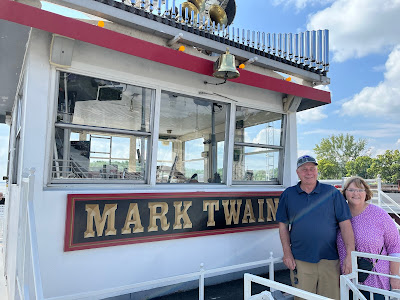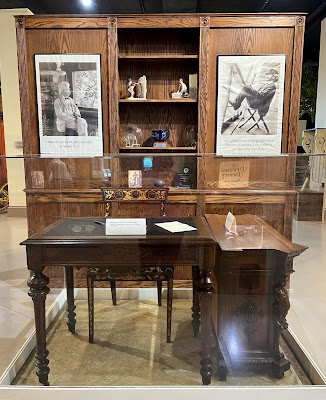
Do you remember as a grade school kid learning that little chant to help you remember how to spell Mississippi? I do, just as easily as I remember that riveting poetry, "Pop, pop, pop, goes the popcorn in the pan! Pop, pop, pop! You can catch me if you can!" (Yes, sometimes I can't remember why I walk in a room, but I remember grade school poetry).
Our trip back from Chicago included a stop in Hannibal, Mo. It is located on the banks of the M-i-s-s-i-p-p-i. As I mentioned in the earlier blog post from LeClaire, Iowa, Randy is fascinated by our country's major rivers. It's not like he grew up by the water - unless you count Peace Creek or Rattlesnake Creek. But he's fascinated, nonetheless.
As we were figuring out our itinerary for the trip to Chicago for the wedding, he planned the stop on our way back home at Hannibal, Missouri. Several weeks before the trip, Randy called the Mark Twain river boat, hoping to book a dinner cruise on the Mississippi. But the day we were to be there, the river boat was booked for a private event. He was disappointed, but we still decided to stop in Hannibal. We could still see the river up close instead of from the top of a highway bridge. And we knew Hannibal provided plenty of history with the Mark Twain museum attractions.
 |
From the shoreline, we watched the Mark Twain river boat set sail that Sunday evening as they motored down the Mississippi with a private group.
|
.JPEG) |
Earlier in the day, we had seen the boat out on the river - along with a dramatic sky!
|
We also got to see a tug boat - the Sir Randall - taking off from the Center Street Landing. However, we weren't able to see it perform its duties after it departed.
We were thrilled to discover there were hour-long scenic cruises offered - sans meal service - on the Mark Twain river boat. We booked two spots on the boat for the next day.
My travel companion was a happy camper - or happy boater.
We sat up on the third deck so we could have a wide open view.

We saw the Mark Twain Memorial Lighthouse from the river. We did not walk up its 244 steps.
I think one of the reasons Randy is interested in major rivers is because they serve as a thoroughfare in moving and exporting grain.
This barge was loaded with wheat. Another barge parked out in the river was loaded with cement from the Continental Cement Plant, a business that's been operating in Hannibal since 1903. The riverboat captain said the company's cement has been used in many construction projects, including the Empire State Building and the Panama
Canal. More recently, the
cement was used in the Minnesota Vikings’ new football stadium and
the St. Louis Cardinals’ newest baseball stadium.
 |
Coming back onto the landing after our cruise.
|
The riverboat captain also recommended going to Riverview Park, and we were glad he did. What beautiful views of the Mighty Mississippi!
From there, we could also see the grain handling facility - another bonus for Randy. It was located right along the river and by a train track.
A giant statue of Mark Twain also looked over the river from the park. It commemorates Twain's days as a riverboat captain. In 1859, he became a licensed pilot on the Lower Mississippi River.

When his piloting career ended with the outbreak of the Civil War in 1861, Clemens went to the Nevada Territory where he first used the pen name Mark Twain in 1863 while writing for The Territorial Enterprise in Virginia City, Nev. Clemens took the name from the river sounding that indicated 12 feet of water, which was safe for navigation.
 |
I told Randy this photo would be more impressive if you couldn't see the cars in the museum parking lot - ha!
|
Before our river excursion, we toured the Mark Twain Museum complex. It included the Huckleberry Finn House, Mark Twain Boyhood Home, Becky Thatcher House, and Grant's Drug Store.
Twain wrote his many books at this desk, including those about Tom Sawyer and Huck Finn.
Mark Twain was a master at "stretching" the truth and adding exciting details to dress up stories. Real people were developed into exciting and colorful characters. He used his childhood in Hannibal to inspire the characters.
The museum has an impressive display of Norman Rockwell art. Already famous for his Saturday Evening Post covers, Rockwell got the opportunity in 1935 to illustrate editions of The Adventures of Tom Sawyer and The Adventures of Huckleberry Finn.
I discovered that none of the previous illustrators had taken the trouble to visit Hannibal, Missouri, where Twain had lived as a boy. ... After I'd been in Hannibal for a few days, I had a sketchbook full of authentic details.
Norman Rockwell
The edition of Tom Sawyer with Rockwell's illustrations appeared in 1936 and Huckleberry Finn in 1940. Rockwell gave them to the Mark Twain Museum before his death in 1978.

As an avid reader and a former newspaper writer and editor, it was interesting to me to learn that Twain was not without his naysayers. Book banning is nothing new.
The Concord (Mass.) Public Library committee has decided to exclude Mark Twain's latest book from the library. One member of the committee says that while he does not wish to call it immoral, he thinks it contains but little humor and that of a very coarse type. He regards it was the veriest trash. The librarian and the other members of the committee entertain similar views, characterizing it as rough, coarse, inelegant, dealing with a series of experiences not elevating, the whole book being more suited to the slums that to intelligent, respectable people.
The Boston Transcript
March 1885
Mark Twain definitely didn't take himself too seriously.
High and fine literature is wine, and mine is only water. But everybody likes water.
Mark Twain
Since we returned home, Randy has re-read both Tom Sawyer and Huckleberry Finn.
 |
The home of Tom Blankenship, who Twain used as inspiration for the character Huck Finn.
|
We also had to visit Becky Thatcher's Ice Cream Parlor.
After leaving Hannibal, we also enjoyed an overnight stop in Kansas City, where we got to see these two.
We ate supper at the Kansas City Taco Co. and had ice cream at Betty Rae's. Then we listened to jazz at the Green Lady Lounge. I didn't get a photo, but we were also glad to see our friend, Barb, before returning home - just in time to make dinner for 40 for the Core group two days later. Back to reality!

.JPEG)

.JPEG)






.JPEG)



.JPEG)
































.JPG)
.JPG)



